

Web 2.o tools 4 teachers. Evaluating learning in the 21st century: a digital age learning matrix - Technology, Pedagogy and Education - Volume 20, Issue 1. Education Technology, Apps, Product Reviews, and Social Media. Edutopia. Integrating Technology for Active Life-long Learning (IT4ALL) Cambridge ESOL: Corporate and research publications. Millennials and Boomers: Building Intergenerational Learning Environments.
Latin America: What's in a Name. Latin America: What’s in a Name?
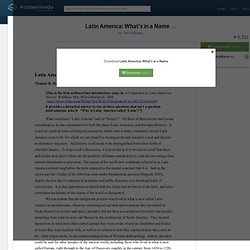
—T. Hollowayp. 2 the external manifestation of the European Renaissance. In the imagination of Europe, peopleand places in the rest of the world only began to exist when they entered the Europeanconsciousness. That consciousness then proceeded to categorize and compartmentalize regions,“races,” and cultures in ways convenient for the purposes of European hegemony (Wolf 1982).One of those compartments has become Latin America, which we need to define moreexplicitly. Not normally included in the rubric Latin America. Th century. Copyright myths, rules, mistakes, issues, and who knows... 3 Articles: mLearning for language teachers. Teacher Quotes.
Qué cosas vale la pena enseñar y aprender hoy. Sites to See. Digital Delights for Learners. Bogus Websites. The 21 Signs you are A 21st Century Teacher. Teaching in the 21st century is definitely not an easy task.
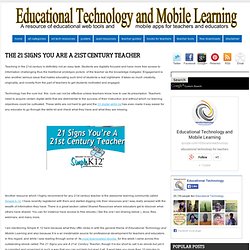
Students are digitally focused and have more free access to information challenging thus the traditional prototypic picture of the teacher as the knowledge instigator. Engagement is also another serious issue that makes educating such kind of students a real nightmare. It takes so much creativity, originality, and novelty from the part of teachers to get students motivated and engaged. Technology has the cure but this cure can not be effective unless teachers know how to use its prescription.
Blog Etiquette in the Educational System. Aulas Abiertas- BA. Surfing the Waves of Change. Las netbooks, los docentes y el aula - 06.05.2012 - lanacion.com. Según el informe del Observatorio de la Educación Básica Argentina -ya comentado aquí a propósito de otros temas-, las computadoras personales del programa Conectar Igualdad que vienen distribuyéndose entre alumnos y maestros casi no se usan en el aula.
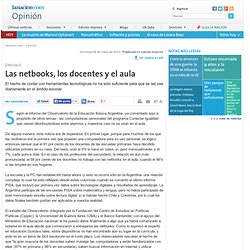
De alguna manera, esta noticia era de esperarse. En primer lugar, porque para muchos de los que las recibieron era la primera vez que poseían una computadora para su uso personal; es lógico entonces pensar que el 91 por ciento de los docentes de las escuelas primarias haya decidido utilizarlas primero en su casa. Del resto, solo el 5% lo hace en clase, sí, pero mensualmente, y el 7%, cada quince días. Flipped Classroom A New Learning Revolution. An expanding ecology of learning options: Visible and Invisible Lea... Prensky-EDTECH-EliminatingtheAppGap-Jan-Feb-2012.pdf (Objeto application/pdf) Teaching News. RSA Animate - Changing Education Paradigms. - e-Literate. Five Best Practices for the Flipped Classroom. Ok, I'll be honest.

I get very nervous when I hear education reformists and politicians tout how "incredible" the flipped-classroom model, or how it will "solve" many of the problems of education. It doesn't solve anything. It is a great first step in reframing the role of the teacher in the classroom. It fosters the "guide on the side" mentality and role, rather than that of the "sage of the stage. " It helps move a classroom culture towards student construction of knowledge rather than the teacher having to tell the knowledge to students. It also creates the opportunity for differentiated roles to meet the needs of students through a variety of instructional activities.
Learning Technology. De la sociedad 1.0 a la sociedad 3.0: ¿escuelas 1.0 para formar estudiantes 3.0. La constante globalización está permitiendo que el conocimiento se distribuya horizontalmente en ámbitos que hasta ahora permanecían incomunicados, creando relaciones heterárquicas y proporcionando la posibilidad de que el conocimiento sea aplicado en contextos innovadores.
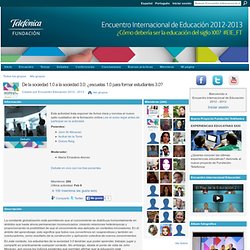
En el ámbito del aprendizaje, esto significa que todos nos convertimos en coaprendices y también en coeducadores, como resultado de la construcción y aplicación colectiva de nuevos conocimientos. En este contexto, los estudiantes de la sociedad 3.0 tendrían que poder aprender, trabajar, jugar y compartir en prácticamente cualquier contexto. Sin embargo, desde el punto de vista de John Moravec, son pocos los indicios existentes que permitan afirmar que la educación está evolucionando hacia el paradigma 3.0. The Failure of One Laptop Per Child. "25 million laptops later," Mashable announced today, "One Laptop Per Child doesn't increase test scores. " "Error Message," reads the headline from The Economist: "A disappointing return from an investment in computing.
" The tenor of these stories feels like a grand "Gotcha! " for ed-tech: It's shiny stuff, sure, but it offers no measurable gains in "student achievement. " So while the OLPC project might have been a good idea, so the story goes, it is not a good investment. Knowmads in Society 3.0. Remember nomads?
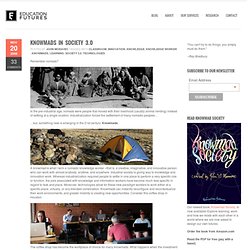
In the pre-industrial age, nomads were people that moved with their livelihood (usually animal herding) instead of settling at a single location. Industrialization forced the settlement of many nomadic peoples… …but, something new is emerging in the 21st century: Knowmads. A knowmad is what I term a nomadic knowledge worker –that is, a creative, imaginative, and innovative person who can work with almost anybody, anytime, and anywhere. Industrial society is giving way to knowledge and innovation work.